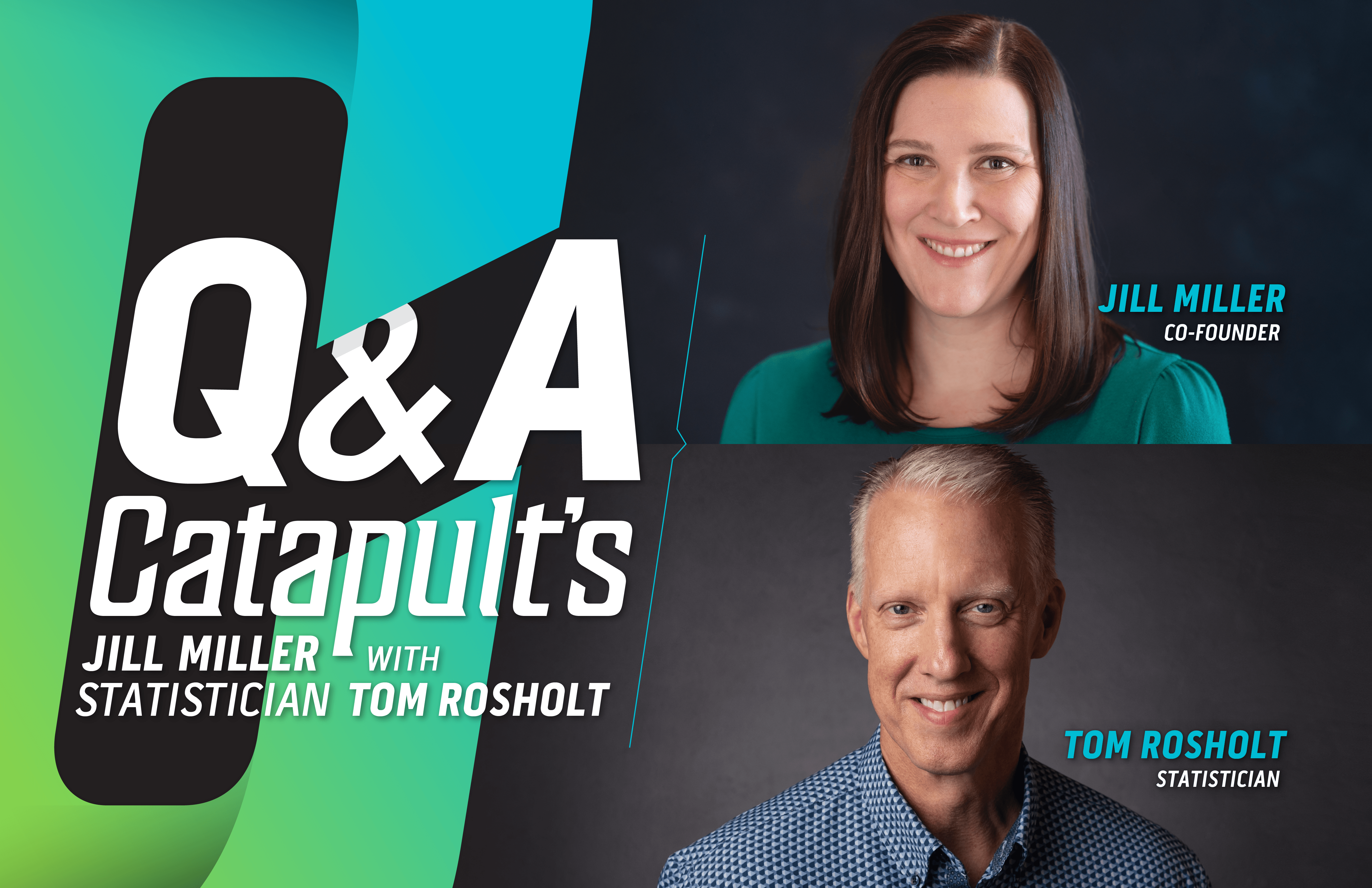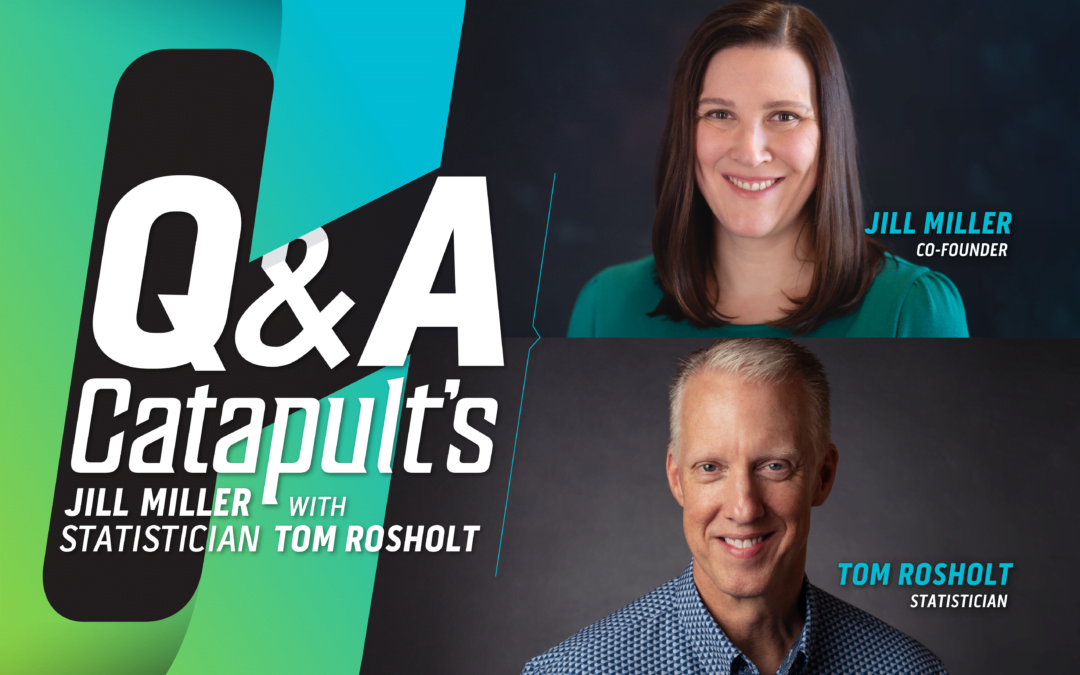Segmentation Q&A with Catapult’s Statistical Expert, Tom Rosholt
In our last segmentation blog I outlined Catapult’s best practices for a successful segmentation. But, there’s one critical best practice that deserves its own post: get yourself a stellar statistician to be you’re analytical partner on every segmentation.
Catapult’s statistician is Tom Rosholt, and I recently sat down with him to chat about all things segmentation.

Jill: Thanks for chatting with me about segmentation today. How long have you been doing segmentation analysis?
Tom: Longer than I’d like to admit – my first exposure was over 20 years ago! As an applied statistician, I’ve been fortunate to have encountered a LOT of analytic techniques across a wide variety of industries over the years. Segmentation is among the things I’ve enjoyed most because it can fundamentally change a business. I’ve had the privilege of being involved in segmentations for clients in a variety of industries including automotive, fashion, CPG, food & beverage, and durable goods, to name a few.
Jill: What do you love most about segmentation? Which part is your favorite?
Tom: I love the interplay among the business/industry, consumer/customer, and research/analytics experts. You can’t do segmentation well without a high degree of collaboration, and that’s what really floats my boat. You become a team that is greater than the sum of its parts, and when you have the right people on the team, it can result in something really special.
My favorite part of the process is identifying the essence of each segment and helping to come up with a catchy name for each. You thought I was going to say the math!
Jill: I really did! Frankly, I find naming to be one of the most challenging parts of a segmentation.
Tom: It may seem counterintuitive that a math nerd likes the challenge of coming up with catchy name. However, names matter because they make it easier to “hold onto” an idea and they elicit a pre-conscious emotional judgment. The right name can make a difference in helping others to understand and embrace a segment (or any idea, really). I love the challenge of taking something as complex as a segment and giving it a pithy and concise label. It is not unlike the statistical process where we represent a complex thing like a data set with a simple thing like a bar graph.
Jill: What was your most successful segmentation and why do you think it was such as success?
Tom: I advised on a segmentation in the automotive space several years back. What I really loved about this particular project was the collaborative nature of it. We had a couple of statisticians, a crackerjack project manager, several category experts, multiple analysts, you name it. I liked how many different people were involved.
On a sports team, there is a role for every player, and if anyone is missing, your chances of success are diminished. Each player brings something vital to the endeavor, and each person on the automotive segmentation team was fully present and engaged. They brought deep knowledge for their area of expertise, and we were able to work as a team, fitting together like pieces of a puzzle.
Jill: What was the most challenging segmentation you’ve ever been a part of and what did you take away from that experience?
Tom: It was many years ago, but I remember it well. It was in a category I don’t know particularly well, and it did not go well because it was a less collaborative process. The client had a very full plate and very little experience with segmentation, so we were missing a critical component of our team – a category expert. They lobbed the requirements over the wall to us to see what we could do with limited input from their team. The role of category expert was impossible to fill by a team of researchers and statisticians who were novices in the category. Ugh.
Jill: That sounds rough. What did you do?
Tom: Well, it ended up being an incomplete piece of research. We found a few useful nuggets but ended up leaving a fair bit of it on the table. While it was a painful process, I learned a lot from it.
Jill: What was your biggest learning or takeaway from this project?
Tom: Start with the end in mind! Always start a segmentation project with a clear understanding of what success will look like at the end, how it will be used, and how it will impact the client’s business. Getting that information up front and setting expectations about client involvement from day one makes a world of difference. I’m super militant about it now (perhaps irritatingly so) and have not repeated that mistake.
Jill: Speaking of mistakes, what’s the biggest mistake you see researchers make when creating a segmentation?
Tom: The biggest sin, for research in general and segmentation specifically, is clinging to a preconceived notion despite evidence to the contrary. As a statistician, I put more stock in what the data say than in any individual opinion. Personal bias is natural and isn’t always a bad thing – when driven by experience, it can actually lead to some useful questions/answers, but it can be tricky to avoid having the tail wag the dog. I encourage my clients to listen to the data and let it guide us rather than trying to steer the analysis in a particular direction. When you do the latter, you run the risk of simply confirming a bias rathing than uncovering some new truth. That’s a colossal waste of resources and potentially dangerous for the business.
Jill: Do you have a favorite statistical technique, methodology, or analysis for segmentation?
Tom: No, I do not. Generally speaking, I am method agnostic. In my opinion, a good statistical model is one that works. I typically recommend that segmentation data be analyzed using multiple techniques, and then make a determination as to what makes sense mathematically, holds up to accepted diagnostic measures, and resonates with the client content experts. It’s not at all uncommon to recommend a solution that isn’t the best from a strict statistical standpoint but makes the most sense to the client in the context of their category and business.
Jill: If you could give one piece of advice to a researcher on the client side who is starting off with their first segmentation, what would it be?
Tom: Always keep these three rhyming words in mind:
Elevate the level of visibility of the project. Make sure that stakeholders are involved at the beginning, middle, and end. You need involvement and buy-in from everyone throughout the process, otherwise it may look like a “black box” solution, and adoption by the organization can become a challenge.
Collaborate. Assemble the right team and ensure that everyone is playing their role. The team, at the very least, should include the subject matter or category experts (often the client team), one or more statisticians, a project manager, and an analyst or two. Then work together and toward the same goal.
Communicate. Segmentation is not a set-it-and-forget-it kind of thing. There should be ongoing communication throughout the process with the core research team and stakeholders. You need to be sharing things like ‘this is what we are doing, what we’ve learned, and what’s next. We’re on version 16 of the questionnaire. We’ve explored 12 segment solutions.’, etc. Expect to “live with” your team part-time during the project. There aren’t that many unilateral decisions to be made in a segmentation – you will enjoy the best outcome by sharing the decisions, the knowledge, and the success.
While every conversation I have with Tom is informative, productive, thought-provoking, and fun, this one got me thinking — perhaps I should rephrase that final segmentation best practice from “get yourself a stellar statistician” to “get yourself a Tom.” Drop us a line if you want to learn more about our approach to segmentation or how we can help you understand your customers in an actionable and meaningful way.
Jill Miller
CO-FOUNDER
CATAPULT INSIGHTS

